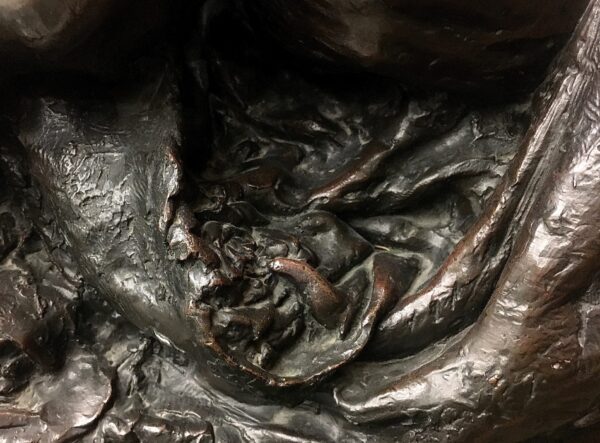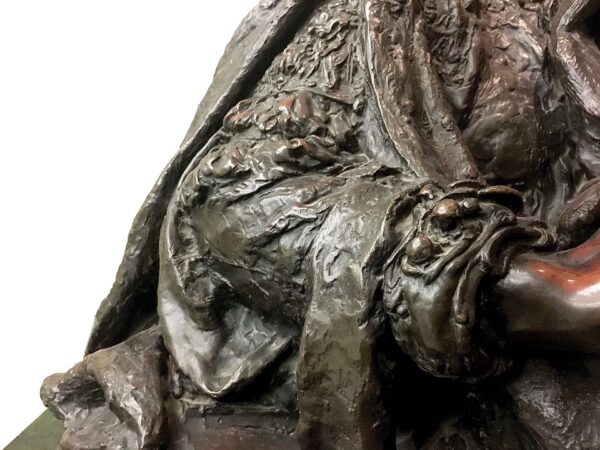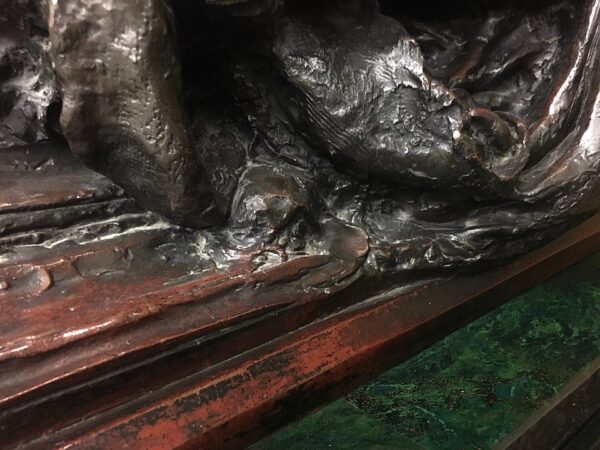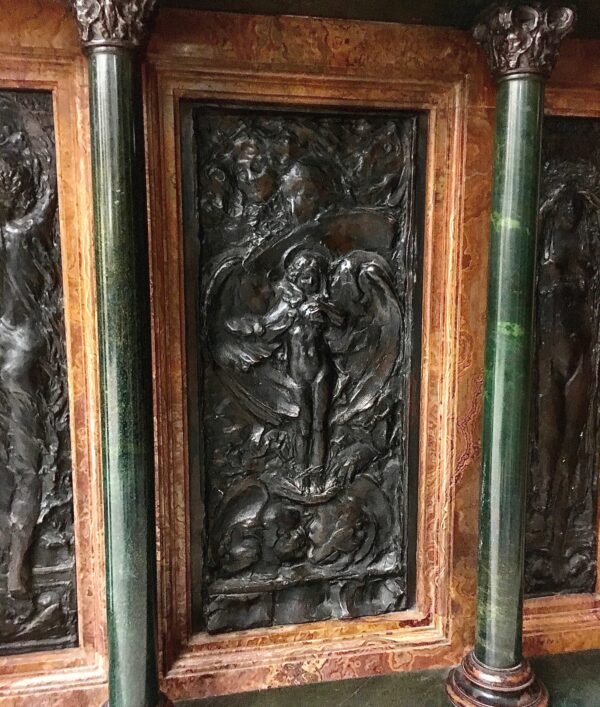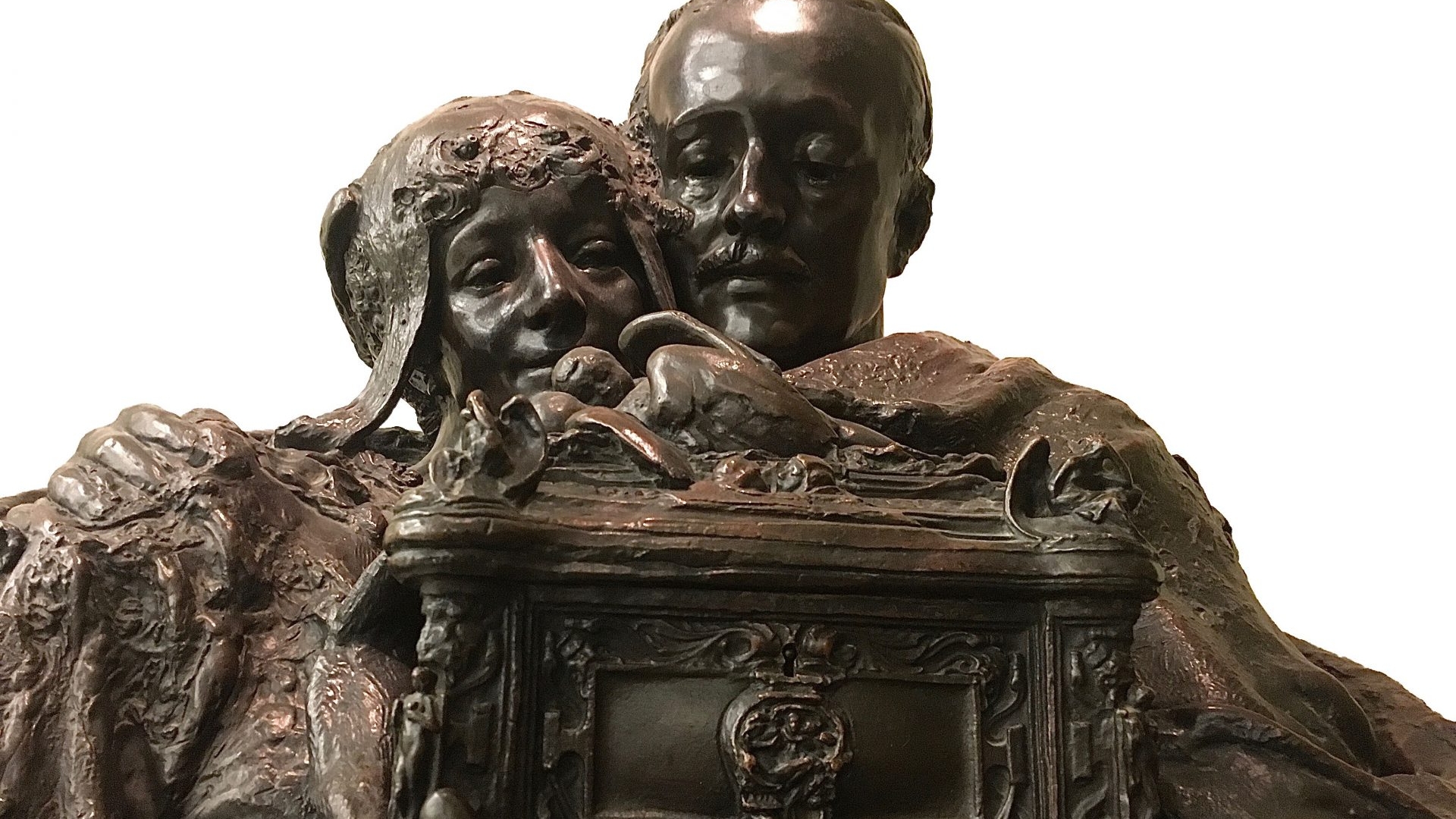
Eros, Thanatos, and the Throuple: Alfred Gilbert’s Mors Janua Vitae (1908)
[This blog post was commissioned by The Courtauld’s Gender & Sexuality Research Group, published 12 August 2020]
Mors Janua Vitae (‘death, the gateway of life’) [Fig. 1] was commissioned by Eliza Macloghlin (1863–1928) in 1904 after the death of her husband Edward (1855–1904). The commanding memorial sculpture is installed, as Eliza intended, in the entrance hall of the Royal College of Surgeons in Lincoln Inn’s Fields, London; Edward had been a doctor (though not a particularly accomplished one) and Eliza’s wealth and resolve ensured his likeness would rest on the College’s prestigious grounds forever.[1] The sculpture features life-sized, half-length bronze portraits of the couple atop a large, rectangular red and green marble base inset with bronze relief panels. Their heads are pressed gently together, arms wrapped lovingly around each other and hands interlinked before them. In the crook of Edward’s elbow is perched a small casket, the shared focus of their downward gaze, its tomb-like design — complete with angelic effigy — a nod to conventional Victorian burial practices [Fig. 2]. But this casket is not merely symbolic: it is, in fact, the Macloghlins’ final resting place, a cinerarium containing their cremated remains.
Longstanding Christian traditions meant that cremation was not yet, in 1904, a common practice, and the Macloghlins’ pagan memorial and ultra-secular resting place bears witness to their rejection of Christian faith.[2] The couple was proudly atheist, and it was ‘in that name’, as Eliza once wrote, that she wished them to be ‘immortalize[d]’.[3] Their memorial is a testament to the enduring power of love, not the divine immortality of the soul or the promise of salvation, and the sculpture’s iconographic programme avoids explicit religious symbolism.[4] The subjects’ embrace, their gaze focused on nothing beyond their own mortal remains, resonates with the love-themed pagan imagery featured on the bronze reliefs embedded in the sculpture’s base, including labelled depictions of ‘Anteros’ [Fig. 3] and ‘Eros’ [Fig. 4]. When a plaster model of the sculpture was first exhibited in 1907, with the identity of its subjects deliberately left obscure, the couple’s loving embrace and cradling of the casket caused one commentator to speculate that the monument symbolised the death of their child.[5] Though he admitted he found its symbolism generally ‘a little difficult to unravel’, this critic nevertheless interpreted the sculpture’s iconography as suggesting a nuclear family — an idea to which I will return. But the Macloghlins had no children: the love celebrated by Mors Janua Vitae is not parental but rather romantic and non-reproductive.
I have been captivated by this sculpture since I first encountered it in 2017, shortly before the closure of the Royal College of Surgeons building for redevelopment. To my mind, the work can be readily situated in relation to Victorian cultural discourses surrounding death, memory, and physical decay. The maker, Alfred Gilbert (1854–1934), was a preeminent figure in the New Sculpture movement of the late nineteenth century, and his sculptures are notable for what David J. Getsy has described as their ‘suppression of the figural’: in Gilbert’s work, bodies are lost beneath ‘layers of ‘imaginative and decorative excess which subsum[e] the statue’, just as the heavy cloak in Mors Janua Vitae buries the bodies of its subjects.[6] His style, informed by his goldsmith’s training, emphasised creation by accretion rather than subtraction, and thus resonates with Victorian scientific descriptions of memory as physically accumulative. ‘The sensation which has passed away’, as physicists Balfour Stewart and P. G. Tait wrote in 1875, ‘leaves behind molecules of the brain’.[7] Memory is thus figured as physically accretive, a layering-on or building-up of matter in the brain, much like the creative process behind Gilbert’s sculpture and formal excesses of his style. These excesses are therefore particularly powerful in a memorial sculpture, whose primary purpose is to a safeguard against disintegrative effects of loss — against the process of forgetting, and thus also of the decay of the bodies of the individuals whose memory the sculpture preserves. If remembering is a process of physical accretion, then commemoration can also be understood, poignantly, as the counteracting of physical decay.
Yet the monument evokes dissolution at least as much as accretion. Accumulated sediment subsumes the bodies, suggesting burial in earth and the natural processes of decay to which such bodies are subject. The rough-textured cloak that engulfs the couple approximates the terrain of Victorian garden cemeteries [Fig. 5], the connection to a necropolis strengthened by the tomb-like casket the Macloghlins cradle. The sculpture’s visual language strongly evokes decay: sections of the cloth are viscerally textured; mushrooms appear to grow from the crook in Eliza’s right arm; and the sculpture as a whole seems, at its base, to disintegrate [Figs. 6, 7, 8]. As Getsy has observed, at least one of Gilbert’s contemporaries referred to the formal excesses of his style as disease-like, a ‘malady [which] attack[ed] the statues’; Getsy further links this to an illness popularly associated with surface lesions and rot: Gilbert’s excessive ornamentation ‘not only enfeebled his figures but threatened to overtake sculpture like a rapidly spreading leprosy’.[8] Though the Macloghlins’ bodies were never interred and would thus never rot, decay is not the only form of physical dissolution: cremation, or disintegration by fire, is another. Its effects are vividly evoked throughout the sculpture: in the relief panels on its base, smoky effects seem to engulf figures’ bodies [Fig. 3]; in the central vertical panel, ghostly faces appear and disappear [Fig. 9], and, just above, the curling detail of the busy scene unfolding in horizontal relief evokes flames licking up towards the portraits of the figures fire would indeed, eventually, consume [Fig. 1].
Like others who have written about Mors Janua Vitae, I am struck by the curious interplay of opposing forces that make up the sculpture: physical accretion and dissolution, commemoration and loss, the permanence of love and bronze and the evanescence of flesh.[9] This interplay mirrors the tensions inherent to an ‘immortaliz[ing]’ (as Eliza put it) memorial to a couple who did not believe in immortality. Their atheism, coupled with Edward’s unremarkable career and the fact that they had no children, meant that for the Macloghlins there was no sense in which their selves would endure after death, either materially or immaterially. The monument itself thus stands in for — or perhaps creates — a sense of futurity or permanence. In Gilbert’s sculpture, the resolution of these tensions seems perpetually deferred, the interplay between opposing forces of accretion and decay, permanence and evanescence, held in a dynamic tension. This tension is, I would argue, generative in its own right — its fluctuations are the source of the work’s curious power.
I find myself drawn to Sigmund Freud’s dual drive theory as a compelling lens through which to consider this sculpture and its tensions. In Beyond the Pleasure Principle (1920), Freud differentiated between two primal and opposing impulses experienced by living beings: the life drive (Eros) and death drive (Thanatos); the former associated with reproduction and self-preservation, the latter with death and dissolution — including the dissolution of the boundaries of the self. Temporally, Eros (sex, love) pushes forwards, through the drive to reproduce; it is creative and generative. Thanatos, by contrast, pulls backwards, destructive, towards the pre-life, pre-differentiated state to which part of the psyche desires always to return. These temporalities in turn evoke the structure of time as frequently represented in Victorian culture (according to M. Norton Wise): linear and ordered on the one hand, circular and disordered on the other. Wise notes that the Victorians readily represented these two sorts of time as gendered: ‘the productive progressive [linear] time of the masculine’ (which we can align with (re)productive Eros), and ‘the repetitive feminized [cyclical] time of the […] masses, who […] threaten to wash over the entire system if not severely controlled’ (which we can align with Thanatos).[10]
The tension in Mors Janua Vitae as I described it above is similarly structured around such opposing drives, invoking both: love, accretion, endurance, and memory, on the one hand; death, decay, impermanence, and dissolution, on the other. What could be more evocative of Thanatos and the impulse to disintegrate the boundaries of the self than the mingling of two individuals’ ashes — a mingling explicitly desired by Eliza?[11] And what more evocative of Eros than a memorial to the enduring power of Love, a product of creativity intended to remain, as Eliza put it, ‘undisturbed for ever in [situ]’?[12] The bronze panel designs on the base of Mors Janua Vitae depict figures explicitly labelled as ‘Eros’ and ‘Anteros’; later in life, as Richard Dorment has noted, Gilbert described his own life as defined by the struggle between these two forces, which he understood (somewhat pace Freud) as the powers of destructive and creative love, respectively.[13] In Gilbert’s own idiom, then, the relief panels on Mors Janua Vitae represent dual, opposing forces along the lines of those described above.
Love in its more painful, destructive form was likely at the forefront of Gilbert’s mind as he worked on this testament to its enduring power: during the sculpture’s production, Gilbert and Eliza developed a passionate, torrid affair. Though the monument is a shrine to the love of Eliza for her husband, the sculpture also contains a physical vestige of her love for Gilbert: the head of Eliza’s likeness, in Mors Janua Vitae, is in fact a hinged cavity, created to house the sculptor’s cremated remains. Though the sculpture depicts the loving embrace of two figures, in its final version it was intended to act as cinerarium for three — a monument to a strikingly unconventional love. Gilbert and Eliza’s relationship ended disastrously in 1908, and his ashes would never find their way into this reliquary, but the monument retains (through the hinged cavity) a physical marker of their entanglement — what Dorment has called ‘a kind of eternal ménage à trois’, a testament to the love of one woman for two men.[14] It is this feature, ultimately, that makes the sculpture an enduring source of fascination for me. Spearheaded by a woman patron at the centre of the threesome — or ‘throuple’ — it inscribes, Mors Janua Vitae monumentalises a sort of love that repudiates conventional romantic and familial structures — a love defined by extra-marital, non-reproductive desire.[15] This ‘throuple’ is a far cry from the societally sanctioned trinity of the nuclear family through whose logic contemporary audiences (like the critic cited above) tried to read the sculpture.
As I continue to develop my thinking on Gilbert’s unusual monument, my argument and the frameworks mobilised above remain provisional: this essay is very much still a work in progress. Yet I sense that ultimately the various strands I have drawn out above can be woven together through a more focused framework attending with greater theoretical precision to gender, sexuality, and temporality as manifest in the monument. On a number of different levels, Mors Janua Vitae holds in tension the opposing forces I have aligned with the (re)productive and progressive features of Eros on the one hand and the destructive and annihilative features of Thanatos on the other — features we can also, as I have mentioned, understand as gendered. Considered in relation to the unconventional love to which it stands testament and to the homoeroticism of Gilbert’s oeuvre more broadly, we might well ask if Mors Janua Vitae’s refusal to straightforwardly privilege the (re)productive and future-oriented ‘Eros’ can be understood as queer.[16] In holding the dissolutive, feminine, and regressive power of Thanatos in productive tension with that of Eros, while also repudiating conventional romantic and hetero-reproductive familial structures, Gilbert’s sculpture troubles a range of Victorian societal hierarchies in a way I hope to explore further elsewhere: those of masculine over feminine, of (re)productive over wasteful, of the progressive over the regressive.
About the author
Emma Merkling is a PhD candidate in History of Art at the Courtauld Institute of Art, supervised by Professor Caroline Arscott. Emma’s research explores the deployment in Victorian art of the imagery, language, and frameworks of late nineteenth-century science, with a particular focus on queer and women artists; heterodox belief systems; and physics, mathematics, and physiological psychology. Previously, Emma received a BA in Art History and Archaeology from Columbia University, and an MA in History of Art from the Courtauld.
References
[1] See Keren Hammerschlag, ‘Eliza Macloghlin and Alfred Gilbert’s ‘Mors janua vitae’, The Burlington Magazine, 159.1376 (November 2017) <https://www.burlington.org.uk/archive/article/eliza-macloghlin-and-alfred-gilberts-mors-janua-vitae> [accessed 6 June 2020](n.p.), for a discussion of Eliza Macloghlin’s negotiations with the Council of the Royal College of Surgeons regarding this unusual request.[2] For an in-depth look at the history of cremation in the Victorian era see Mary Elizabeth Hotz, Literary Remains: Representations of Death and Burial in Victorian England (Albany: State University of New York Press, 2009), pp. 139–143. She discusses the ‘cremation movement’, spearheaded by scientists who, from the late 1860s on, pushed for cremation as a more practical and hygienic form of disposing the corpse. In 1902 the Cremation Act was passed, legalising and regulating cremation practices in England, but cremation continued to face passive resistance among until around 1914. See also Nancy Rose Marshall, ‘Victorian Imag(in)ing of the Pagan Pyre: Frank Dicksee’s Funeral of a Viking’, 19: Interdisciplinary Studies of the Long Nineteenth Century25 (2017), 1–37 https://doi.org/10.16995/ntn.795, for more on cremation and the Victorian visual imagination.
[3] Letter from Eliza Macloghlin to the Royal College of Surgeons, 8 June 1904, Royal College of Surgeons, London, RCS-SEC/70. Emphasis original. Cited in Richard Dorment, ‘The Loved One: Alfred Gilbert’s Mors Janua Vitae’, in Victorian High Renaissance: George Frederic Watts 1817–1904, Frederic Leighton 1830–96, Albert Moore 1841–93, Alfred Gilbert 1854–1934 : An Exhibition (Minneapolis: The Minneapolis Institute of Arts, 1978), pp. 42–52 (p. 43), and in Hammerschlag (n.p.).
[4] Dorment, p. 47; Hammerschlag (n.p.).
[5] Rudolf Dircks, ‘Royal Academy Exhibition, 1907’, Art Journal, July 1907, pp. 193–207 (p. 207). ‘[T]he two embracing figures holding the casket suggest — and the idea is a beautiful one — that they have become united by a common affliction, by possibly the death of their children.’ Cited in Hammerschlag (n.p.). Hammerschlag notes that it was the sculptor, Alfred Gilbert, himself who wished the sculpture to be displayed ‘without identity’.
[6] David J. Getsy, Body Doubles: Sculpture in Britain, 1877–1905 (New Haven: Yale University Press, 2004), p. 116. Getsy is referring to ornament and decorative excess, but the cloak in Mors Janua Vitae has much the same material effects as those he describes.
[7] Balfour Stewart and Peter Guthrie Tait, The Unseen Universe; or, Physical Speculations on a Future State(New York: Macmillan, 1875), p. 48.
[8] Lorado Taft, Modern Tendencies in Sculpture (Chicago: University of Chicago Press for the Art Institute of Chicago, 1921), p. 77 (from a lecture originally delivered in 1917); Getsy, p. 116.
[9] See especially Hammerschlag, who describes ‘a tension that is expressed throughout the work between immortality and decay, heaven and earth, a divine, eternal love and a murkier, earthbound one’ (n.p.).
[10] M. Norton Wise, ‘Time Discovered and Time Gendered in Victorian Science and Culture’, in From Energy to Information: Representation in Science and Technology, Art, and Literature, ed. by Bruce Clarke and Linda Dalrymple Henderson, (Stanford: Stanford University Press, 2002), pp. 39–58 (p. 51).
[11] In her will, Eliza wrote that she wanted her ashes ‘to mingle with those of [her] late husband contained in the Bronze casket.’ See will and testament of Eliza Macloghlin, codicil dated 28 May 1913, Royal College of Surgeons, London; cited in Hammerschlag (n.p.). Hammerschlag has also noted how the sculpture’s rough surface resembles ‘the original clay’ — a feature we might also align with the pre-life state to which Thanatos urges return.
[12] Letter from Eliza Macloghlin to the President and Council of the College, 8 May 1911, Royal College of Surgeons, London, RCS-SEC/70; cited in Hammerschlag (n.p.).
[13] Dorment, p. 44.
[14] Dorment, p. 46.
[15] Hammerschlag has discussed Eliza’s persona which, ‘as conveyed through the prism of her relationship with Gilbert, oscillates between devoted widow and beguiling madwoman — two gendered Victorian stereotypes’ (n.p.). Hammerschlag herself sees the monument as providing evidence of the ‘complexities of Victorian widowhood’ as it was experienced by the woman who commissioned [it]’ (n.p.).
[16] For scholarship on homoeroticism and Gilbert’s oeuvre more broadly, see Jason Edwards, Alfred Gilbert’s Aestheticism: Gilbert Amongst Whistler, Wilde, Leighton, Pater and Burne-Jones (London and New York: Routledge, 2016).







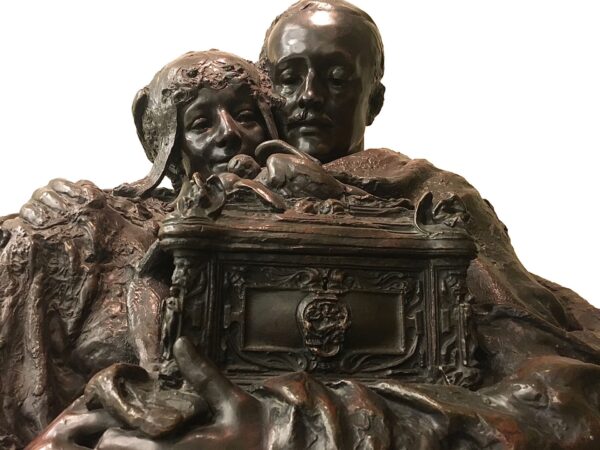
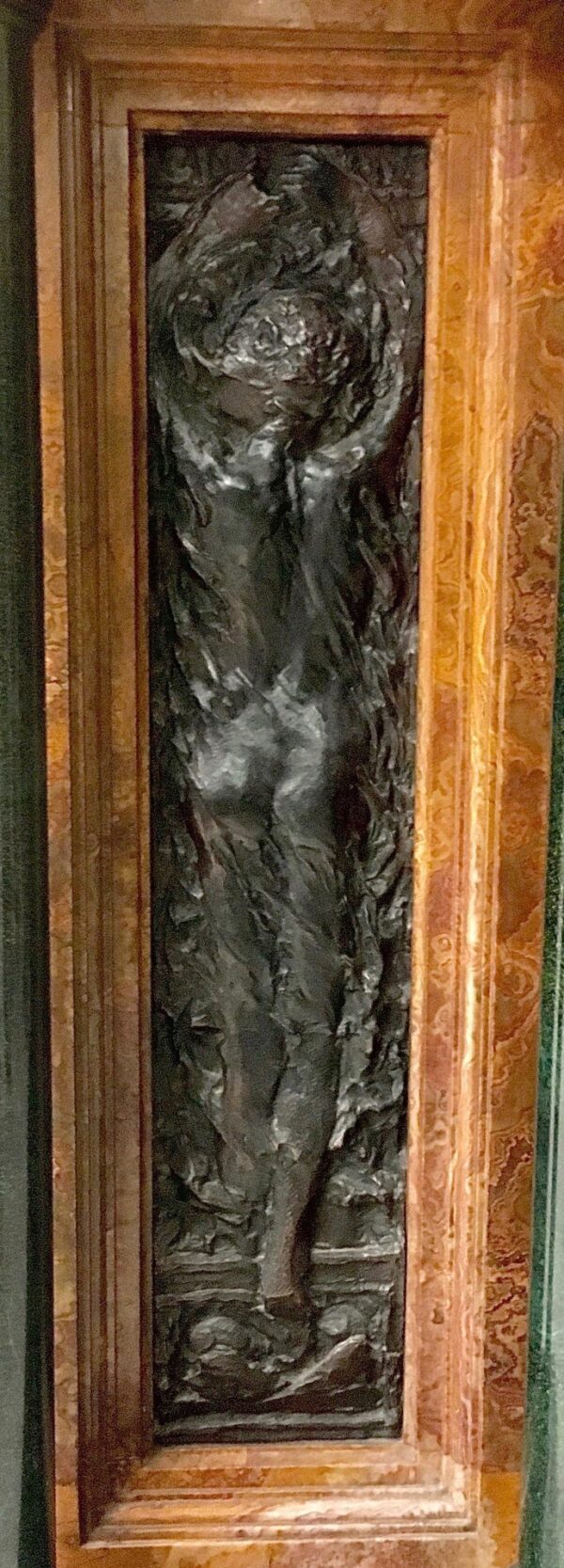

![‘The [West] Norwood Cemetery’ (engraving)](https://courtauld.ac.uk/wp-content/uploads/2021/04/Fig.-5.--600x0-c-default.jpg)
